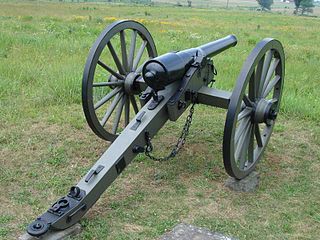
The 63rd New York Infantry Regiment was a Union Army regiment in the Irish Brigade during the American Civil War. It served in some of the leading campaigns and battles of the Army of the Potomac in the Eastern Theater of operations.
The 4th Pennsylvania Cavalry Regiment was a cavalry regiment of the Union Army during the American Civil War.
The 1st Connecticut Cavalry Regiment was a cavalry regiment that served in the Union Army during the American Civil War.

The 52nd New York Infantry Regiment was an infantry regiment in the Union Army during the American Civil War.

The 126th New York Infantry Regiment was an infantry regiment in the Union Army during the American Civil War.
The 145th Pennsylvania Volunteer Infantry was an infantry regiment that served in the Union Army during the American Civil War.

The 108th New York Infantry Regiment was an infantry regiment in the Union Army during the American Civil War.
The 8th New Jersey Infantry Regiment was an infantry regiment in the Union Army during the American Civil War.

The 120th New York Infantry Regiment was an infantry regiment in the Union Army during the American Civil War.

The 1st Massachusetts Volunteer Cavalry Regiment was a cavalry regiment that served in the Union Army during the American Civil War.
The 1st Pennsylvania Cavalry was a cavalry regiment that served in the Union Army as part of the Pennsylvania Reserves infantry division during the American Civil War.

The 8th Pennsylvania Cavalry was a cavalry regiment that served in the Union Army during the American Civil War.
The 13th Pennsylvania Cavalry Regiment was a cavalry regiment that served in the Union Army during the American Civil War.

The 16th Pennsylvania Cavalry was a cavalry regiment that served in the Union Army during the American Civil War.

The 95th New York Infantry Regiment was an infantry regiment in the Union Army during the American Civil War.

The 56th Pennsylvania Volunteer Infantry was an infantry regiment that served in the Union Army during the American Civil War. The unit has the distinction of being the first Union Army infantry regiment to open fire at the Battle of Gettysburg.

The 97th New York Infantry Regiment was an infantry regiment in the Union Army during the American Civil War.
Battery "C" 4th Regiment of Artillery was a light artillery battery that served in the Union Army during the American Civil War.

The 4th U.S. Artillery, Battery E was an artillery battery that served in the Union Army during the American Civil War. The unit fought at the battles of Kernstown, Port Republic, Rappahannock Station, Second Bull Run, Chantilly, Antietam, and Fredericksburg in 1862. The battery transferred to the Cavalry Corps where it served for the rest of the war. In 1863, 4th U.S. Artillery, Battery E fought at Chancellorsville, Gettysburg, Culpeper, Bristoe Station, and Mine Run. In 1864, the unit fought at the Wilderness, Todd's Tavern, Yellow Tavern, Totopotomoy, Cold Harbor, the Wilson-Kautz Raid, Opequon, Fisher's Hill, and Cedar Creek. In 1865, it saw action at Dinwiddie Court House, Five Forks, Sailor's Creek, and Appomattox before taking part in the Grand Review of the Armies.

The 6th New York Cavalry Regiment, also known as the 6th Regiment New York Volunteer Cavalry and nicknamed the "2nd Ira Harris Guards", was a cavalry regiment of the Union Army during the American Civil War. The majority of its fighting was in Virginia as part of the Army of the Potomac.







